Reservoir water level prediction using combined CEEMDAN-FE and RUN-SVM-RBFNN machine learning algorithms
IF 4.3
Q1 WATER RESOURCES
引用次数: 0
Abstract
Accurate prediction of water level changes in reservoirs is crucial for optimizing the operation of reservoir projects and ensuring their safety. This study proposed a method for reservoir water level prediction based on CEEMDAN-FE and RUN-SVM-RBFNN algorithms. By integrating the adaptive complete ensemble empirical mode decomposition with adaptive noise (CEEMDAN) method and fuzzy entropy (FE) with the new and highly efficient Runge–Kuta optimizer (RUN), adaptive parameter optimization for the support vector machine (SVM) and radial basis function neural network (RBFNN) algorithms was achieved. Regression prediction was conducted on the two reconstructed sequences using SVM and RBFNN according to their respective features. This approach improved the accuracy and stability of predictions. In terms of accuracy, the combined model outperformed single models, with the determination coefficient, root mean square error, and mean absolute error values of 0.997 5, 0.241 8 m, and 0.161 6 m, respectively. In terms of stability, the model predicted more consistently in training and testing periods, with stable overall prediction accuracy and a better adaptive ability to complex datasets. The case study demonstrated that the combined prediction model effectively addressed the environmental factors affecting reservoir water levels, leveraged the strength of each predictive method, compensated for their limitations, and clarified the impacts of environmental factors on reservoir water levels.
结合CEEMDAN-FE和RUN-SVM-RBFNN机器学习算法进行水库水位预测
水库水位变化的准确预测对水库工程的优化运行和保障安全至关重要。提出了一种基于CEEMDAN-FE和RUN-SVM-RBFNN算法的水库水位预测方法。通过将自适应全集成经验模态分解方法(CEEMDAN)和模糊熵(FE)与新型高效的龙格-库塔优化器(RUN)相结合,实现了支持向量机(SVM)和径向基函数神经网络(RBFNN)算法的自适应参数优化。根据重构序列的特征,分别使用SVM和RBFNN对重构序列进行回归预测。这种方法提高了预测的准确性和稳定性。在精度方面,组合模型优于单一模型,决定系数为0.997 5,均方根误差为0.241 8 m,平均绝对误差为0.161 6 m。在稳定性方面,模型在训练和测试期间的预测更加一致,整体预测精度稳定,对复杂数据集的适应能力更好。实例研究表明,该组合预测模型有效地解决了影响水库水位的环境因素,充分发挥了各种预测方法的优势,弥补了其局限性,明确了环境因素对水库水位的影响。
本文章由计算机程序翻译,如有差异,请以英文原文为准。
求助全文
约1分钟内获得全文
求助全文
来源期刊

Water science and engineering
WATER RESOURCES-
CiteScore
6.60
自引率
5.00%
发文量
573
审稿时长
50 weeks
期刊介绍:
Water Science and Engineering journal is an international, peer-reviewed research publication covering new concepts, theories, methods, and techniques related to water issues. The journal aims to publish research that helps advance the theoretical and practical understanding of water resources, aquatic environment, aquatic ecology, and water engineering, with emphases placed on the innovation and applicability of science and technology in large-scale hydropower project construction, large river and lake regulation, inter-basin water transfer, hydroelectric energy development, ecological restoration, the development of new materials, and sustainable utilization of water resources.
 求助内容:
求助内容: 应助结果提醒方式:
应助结果提醒方式:


